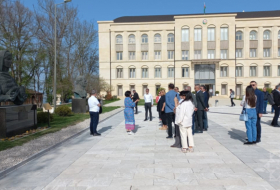When Elfenbein herself looked at photographs, she realised that she could tell which were which. Her collaborator, Abby Marsh, found that she could too. So they ran an experiment.
They found that the Americans they tested were also strangely good at spotting who was Japanese and who was Japanese-American, even though they were all ethnically the same. The subjects wore the same clothes, and were lit in the same way. When the two groups held neutral expressions, people could barely differentiate between them. But when they showed their feelings, especially sadness, something from Japan or America seemed to emerge.
You may have had this experience yourself, if you’ve ever been abroad and felt suddenly convinced that a passing stranger is one of your fellow countrymen. At times the signal may be obvious.
If you’ve seen the film Inglourious Basterds, you will know that German and British people indicate the number three with their fingers in different ways. (Germans raise their thumb and first two fingers; Britons pin the little finger with their thumb and raise the rest.) Most never realise that this difference exists until they see the alternative, which, to them, looks strange.
Some signals may be random quirks that happened to catch on. Others may have served a purpose. Vladimir Putin is said to display his KGB weapons training in the way he walks, with his “gun arm” hanging motionless by his side.
Since their initial discovery, Marsh and Elfenbein have detected more of these “non-verbal accents” – physical ways in which we show where we come from without realising. Americans, for example, can spot Australians from the way they smile, wave or walk.
Even facial expressions during orgasm carry different “cultural accents”
“It was so easy to find,” says Marsh. “We ran those two studies, and we found the same effect in both studies. In the behaviours that we looked at, it was all right there.”
More recent research supports their findings. A team at the University of Glasgow has now trained a computer to recognise and then generate more than 60 different non-verbal accents on a simulated face. Subtle, almost indecipherable differences in the way a nose wrinkles and a lip is raised were often all that differentiated them. But when East Asians were shown these artificial “East Asian” expressions, they recognised them much more easily than “Western” ones. “It’s harder than it sounds,” says Rachael Jack, whose lab conducted the research. Before they could even begin, for instance, Jack and her team had to establish which words in English and Chinese referred to roughly corresponding feelings.
Although in principle, Jack says a robot should eventually be able to simulate the tiny nuances for any culture, and any occasion, in the world. In a study last year, Jack and others found that even facial expressions during orgasm carry different “cultural accents”.
The fact that non-verbal accents exist shouldn’t be that surprising. People recognise individual voices and faces, and even walking or running styles, without knowing exactly what makes them recognisable. The Chinese technology company Watrix claims that their software can identify a person from footage of them walking, with accuracy of up to 94%. If an individual’s movements can be so distinctive, then it is not unreasonable to think that groups might share a few in common, and that this might be noticeable to outsiders.
There is already evidence that we read more from body posture than we realise. In a 2012 study, people who were shown photographs of tennis players taken immediately after an important point were much better at knowing whether the player had won or lost from images of their bodies than of their faces. When losing faces were placed on winning bodies, or vice versa, it was the bodies that overwhelmingly guided people’s judgements. A later version of the study produced the same findings, along with the fact that Hong Kong college students did better overall when the athletes were East Asian, which again suggests that we are better at spotting those postural accents that we are most familiar with because we see them in the people around us.
In his recent book, The Human Swarm, biologist and photographer Mark Moffett speculates that non-verbal accents serve as social markers, which help people to tell “us” from “them”. Sometimes they seem to carry more detailed information, not all of it reliable. In a classic study, psychologists at Princeton University found that participants were good at picking election winners just by choosing who looked more “capable” from a pair of photographs. Even children became good political pundits when they were shown the same pictures and asked to choose an imaginary “captain” for a video game. Still, there appears to be no connection between looking reliable, and being it.
On the other hand, some faces do seem to record information about the life they’ve lived. When shown a selection of neutral expressions taken from dating apps, participants in a 2017 study were able to tell rich people from poor more accurately than if they were just guessing. Indeed they could still do it with pictures of only the person’s eyes or, in particular, their mouth. After further investigation, the researchers came to the conclusion that rich people just look a little more attractive or more positive (a mixture of happy and likeable) than poor people do. When shown photographs in which everybody was smiling and looking deliberately positive, participants lost their ability to tell rich and poor apart.
The presence of these subtle cues might help to explain the bias that can creep into our thinking about people from different backgrounds. As we’ve seen, non-verbal accents often have the effect of making outsiders more difficult to understand.
When people want to be understood, however, they do have ways to make their feelings clear.
One ingenious but speculative recent study from the University of Wisconsin-Madison suggests that this might even have given an upbeat accent to modern Americans. The theory is that the residents of a place experiencing high immigration will often struggle to understand each other, but in order to cope in ordinary life they have to try. As a result, the authors guessed that a lot of smiling and pantomiming of emotions would have been required.
When they checked the available data, they found that people in countries with “high ancestral diversity", including the US, reported smiling more often. Even looking state-by-state within the US, the same pattern emerged. If outsiders seem cold and snooty to Americans, and Americans seem inanely cheerful to everyone else, then perhaps their diverging histories might explain why these stereotypes evolved.
At the very least, when people really want to understand each other, non-verbal accents show us that it’s good to talk.
BBC
More about: Merkel
















































